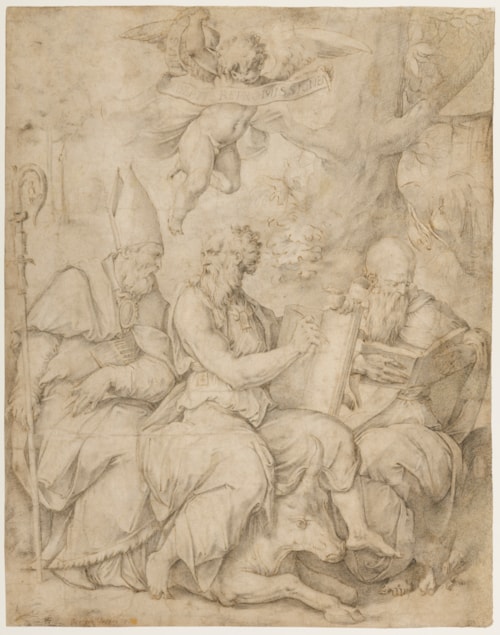
Giorgio VASARI
Arezzo 1511 - Florence 1574
Biography
Best known today as the author of the magisterial Vite de’ piu eccelenti pittori, scultori ed archittetori, first published in 1550 and again in an expanded edition in 1568, Giorgio Vasari was a painter, architect, art historian and collector. A native of Arezzo, he settled in Florence in 1524, studying there with Andrea del Sarto, Baccio Bandinelli and Rosso Fiorentino before undertaking a trip to Rome in 1532. Among his major commissions were the fresco decoration of the salone of the Palazzo della Cancelleria in Rome, painted in 1546 for Cardinal Alessandro Farnese, and the extensive decoration of the various rooms of the Palazzo Vecchio in Florence, a massive project planned and designed by Vasari and completed by him and a team of artists under his direction in 1572. In the 1560s he and his workshop also undertook the painting of altarpieces for several Florentine churches, notably in Santa Croce and Santa Maria Novella. Vasari was one of the founders of the Accademia del Disegno in Florence, established under the patronage of Cosimo I de’Medici in 1563. Apart from Florence, Rome and Arezzo, he worked in Bologna, Cortona, Naples, Ravenna, Venice and elsewhere, and his patrons included three popes, two Grand Dukes of Tuscany and numerous wealthy noblemen, as well as many religious and secular institutions. Also active as an architect, Vasari was involved in a number of renovations of medieval churches in the 1560s, including Santa Maria Novella and Santa Croce in Florence and Santa Maria delle Pieve and the Badia in Arezzo. He also designed the loggia of the Palazzo degli Uffizi and the Vasari Corridor, leading from the Uffizi to the Palazzo Pitti, which was completed in 1565. Near the end of his life, he and his assistants painted a cycle of frescoes in the rooms of his house in Borgo Santa Croce in Florence, and he began work on an enormous fresco of The Last Judgement on the cupola of the nearby Duomo; a project completed after his death by Federico Zuccaro.
Vasari was a gifted and prolific draughtsman, and around five hundred drawings by him survive today, the vast majority held in two public collections, namely the Louvre in Paris and the Uffizi in Florence. (This may represent only a part of his total output of drawings, however, since relatively few sheets survive from the artist’s early career, with one such loss being a putative album of anatomical studies.) He generally worked in either pen and ink and wash or black or red chalk, sometimes on coloured paper, and a particular penchant for blue paper is evident in his work following a stay in Venice in the 1540s. Vasari was also an avid collector of drawings by other artists, building up a substantial collection that he carefully assembled into albums, which he referred to as his Libro de’ disegni.



